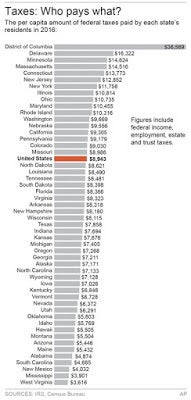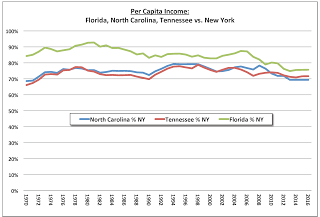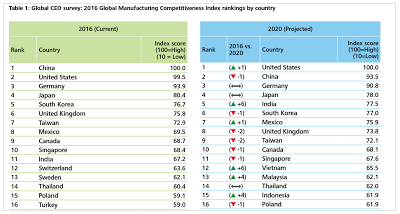According to the New York Times, Amtrak’s Northeast Corridor needs a $28 billion overhaul, including, most significantly, the replacement tunnel under the Hudson River connecting New York and New Jersey. The significance of the tunnel project is hard to overstate, yet Republicans in Congress ― now with White House backing ― appear almost gleeful at the prospect of defunding the railroad and crippling the region. Perhaps it is payback for the famous Saul Steinberg’s New Yorker cover and all that it represents; GOP members of Congress from the flyover states are itching to tell Amtrak to go f―k itself.

It is an odd way to say thank you. The Northeast Corridor is an essential transportation artery in one of the two most economically vital regions ― along with California ― that drive the nation’s economy, and in terms of annual contributions to the federal government, it stands alone. Given the disproportionate amount of funding that the region contributes to the federal government, one would not think that supporting badly need capital investment required by that critical rail link was too much to ask.
A quick look at the Associated Press’s list of per capita federal taxes paid by states tells the story. The states served by the Northeast Corridor ― from north to south ― Massachusetts, Rhode Island, Connecticut, New York, New Jersey, Pennsylvania, Delaware and Maryland represent eight of the fourteen leading states in terms of federal taxes paid per resident.

Year in and year out, those states ― along with most of their blue state brethren ― are net payers of federal taxes while most red states take out more than they pay in. It would be one thing if there was a hint of appreciation expressed by those deep red states to the productive states that provide all that money, but listening to the braying coming from the halls of Congress these days ― and the hostility to funding Amtrak’s Northeast Corridor is just one example ― one would think that it was the red states that were supporting the rest of the country.
With Republicans in full control, the Northeast Corridor states are taking it on the chin. It would be one thing if the GOP simply wanted to take the axe to Amtrak ― it has been a favored target of budget cutters for decades ― but now Republicans are determined to stick it to the blue states on the tax side as well.
Right at the top of the GOP tax reform agenda ― and reflected in the Trump tax plan as well ― is eliminating the federal deductibility of state and local taxes. This is both a money grab and a political power play. As illustrated in the “tax burden” graphic below, the states that pay the most federal taxes per capita ― the Northeast Corridor, Midwest and West Coast ― tend to have higher state and local taxes than the lower-tax “taker” states as well. For decades, conservative economists such as Art Laffer, Stephen Moore and Larry Kudlow have argued that it was only a matter of time before those low tax red states became the shining stars of economic growth.

Yet, for some reason, despite low taxes ― and decades of subsidies from the high tax states ― the future never comes. Federal taxes paid per capita here are directly tied to income per capita of each state, and ― despite the predictions of moralizing tax cutters ― those Northeast Corridor states, from Taxachusetts down to Maryland, continue to produce higher real incomes across their populations and subsidize those low tax, conservative shining stars of Florida, Tennessee and North Carolina, and their brethren. For example, as illustrated in the graph here, per capita incomes in Florida, Tennessee and North Carolina remain essentially unchanged compared to New York State since 1970, a half century ago.

For decades now ― as documented by the conservative Tax Foundation ― more productive blue states have seen their money flow to less productive red states. Yet somehow those red state Republicans get away with saying ― as we now hear in the tax reform discussions on Capitol Hill ― that the deductibility of state and local taxes represents a subsidy by the low tax to the high tax states. While this might be true in a narrow mathematical sense, whatever benefit that deduction provides to taxpayers in high tax states is a pittance compared to the overwhelming subsidies that flow the other way.
It is not that Republican lawmakers object to some states subsidizing others ― after all, Republicans are more likely to represent taker states than payor states. What those Republicans object to is subsidizing what they assert is morally bad behavior on the part of blue states: taxing citizens to pay for government.
Yet, blue state Democrats look at the same circumstances and see a very different picture. From their vantage point, those higher taxes that Republicans find objectionable go in large part to fund investments in K-12 and higher education that directly contribute to the higher real incomes in blue states ― which in turn have resulted in the higher per capita federal tax payments that are used, in part, to subsidize red states. In the view of those blue state Democrats, red state politicians who prioritize low taxes ― and as a consequence suppressing education funding ― are making policy choices that result in lower levels of education attainment across their communities, and contribute to lower real incomes and less financial security over time.
In the wake of a presidential election that swung on the devastation wrecked by globalization on less educated populations, one might have imagined that elected officials from those ravaged communities would be focused on the urgency of investments in education to support community economic vitality and family financial security. But instead of pointing to the factors that produce economic success and security over the long term ― for individuals, families and communities ― we just hear more of the same old, same old, as red state politicians continue to hector blue states about what taxes cost, rather than what they produce.
To the extent that the emphasis on low taxes has undermined educational attainment in red state America, the anti-tax Reagan Revolution has turned the GOP into a fount of public policy moralism that has undermined the economic success and security of those communities that it represents. In the modern world, where capital flows to those places that offer the greatest opportunity for an economic return, low taxes are not enough; investments in education and human capital matter. Now, more than ever, investments in primary, secondary and higher education have become critical drivers of long-term economic growth at the state level.
On Wednesday, Treasury Secretary Steve Mnuchin and Trump economic tsar Gary Cohn introduced the key parameters of Donald Trump’s tax cut plan. As in all things Trump, the proposed plan was billed as the largest ever. As if on cue, two days after the press conference introducing the plan, first quarter economic growth came it at a 0.7 percent annualized rate, an unexpected slowdown in economic growth that will surely lead to clamoring among Republicans in support of something approximating Trump’s tax proposals.
The problem is that for the Trump base ― less educated working class whites ― taxes are not the problem and tax reform will not cure what ails them. Despite Trump’s American Carnage rhetoric ― and the urgency that Mnuchin and Cohn sought to convey ― the US economy has been the envy of the advanced economies in its resiliency and rebound from the 2008 financial collapse. The major constraint facing domestic economic expansion is not availability of capital or tax treatment of corporate profits, but tight labor markets and availability of skilled labor. To the extent that proposed tax cuts accelerate US corporate investment and job creation, the primary impact is likely to be increased upward pressures on wages for existing skilled workers rather than the return of jobs to the hardest hit rural communities that have been the focal point of the Trump phenomenon.

Even as the Tax Foundation, Larry Kudlow, Stephen Moore and others have bemoaned the lack of competitiveness of the US corporate tax structure as they make the case for Trump’s massive tax cuts, the Boston Consulting Group, Deloitte (shown here) and McKinsey have published studies showing that the United States offers one of, if not the most, attractive climate for new investment across the globe. Those studies conclude that manufacturing costs in the United States today ― driven by factors including rising wages in developing countries, low domestic energy costs, and rising productivity ― are only marginally higher than in China, with trends that continue to improve.

Donald Trump’s populist politics have turned the discussion of US competitiveness and job creation on its head. The carnage of Trump’s imagination is not a national phenomenon, but a localized one. Nationally, the unemployment rate is low and middle-class real incomes are growing, even as rural communities have been devastated by economic trends. Rather than encouraging families and communities to understand the critical importance of investment in education to real income growth and security over the long-term, Trump ― like generations of Republicans before him ― has chosen instead to play upon the resentments of less educated voters in exurban and rural areas toward economic elites in the relatively successful blue states and urban centers, while promoting tax cuts that offer little or no long-term value to them or their communities.
The states along Amtrak’s Northeast Corridor have done well by their residents over the years. Decade after decade, those states have contributed far more to the federal kitty than they have taken out. Yet for all their success ― and the billions of dollars they pour into the pockets of red state taxpayers year after year ― they continue to be subject to resentment and derision from Republicans in Congress, who take their money and then tell them to pay for their own railroad. Those same politicians, in pursuit of their own advancement, ignore the critical links between educational attainment, and family incomes and financial security, and push policies of cutting taxes rather than investments in education that might improve the welfare and financial security of their constituents over time.
Follow David Paul on Twitter @dpaul. Artwork by Jay Duret. Check out his political cartooning at www.jayduret.com. Follow him on Twitter @jayduret or Instagram at @joefaces.
